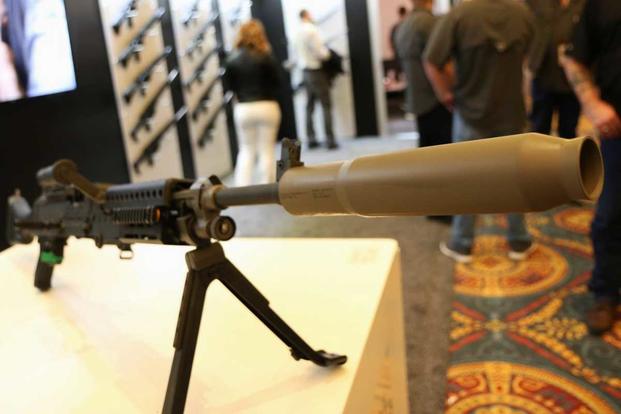LAS VEGAS -- Radical Firearms has unveiled its new machine-gun suppressor, which was recently selected to be evaluated under a Joint Special Operations Command (JSOC) program.
The new 240 FVS Machine Gun Suppressor, tailored for the M240 machine gun, is designed to drastically exceed special-operations forces' performance requirements, Mel Miranda, marketing director for military and law enforcement sales at Radical Firearms, said at SHOT Show 2020.
The 3D-printed 240 FVS suppressor can handle up to 1,500 rounds of continuous M240 fire, far exceeding the JSOC suppressor requirement for 600 rounds of continuous fire, Miranda said.
It runs 250 to 300 degrees cooler than other suppressors on the market, said David Spector, chief operating officer for Radical Firearms.
Related: SHOT Show 2020 Coverage
"It creates an open flow of air, so that as you are shooting this weapon with a 1,000-round belt, you can go into a firefight and not melt the suppressor," Spector said. "You will melt the barrel down before you melt the suppressor."
Officials from the Naval Surface Warfare Center’s Crane, Indiana division tapped the 240 FVS for future evaluation at the Special Operations Forces Warrior Operational Requirements Discussion Symposium (SWORDS) in Tampa, Florida, in early November, Spector said.
"They have approached us and requested the suppressor for testing," he said.
The 240 FVS operates on the same principle as the 1906 Lewis, a light machine gun that saw extensive use during World War I, Spector said.
"It creates a high-pressure shock wave in the machine gun itself and pulls air through it to cool the machine gun," he said. "This is an air-cooled suppressor; it's based off the Lewis Gun."
That type of technology has been abandoned for years, Spector explained.
"Firms have gone to more robust materials ... and they think that they can defeat heat. Well, heat is a booger," he said. "Additive manufacturing allows you to ... eliminate traditional machining, and it's kind of the sky's the limit."
Spector admits that the 240 FVS is "actually pretty heavy" at four pounds, but he is confident that it outperforms other suppressors on the market.
"When we have done testing ... some of these other cans that say 'they breathe and do things' -- they actually run really hot and they start melting," he said.
The 240 FVS is designed to form what is known as the Venturi effect, which creates a vacuum for heat and pressure.
"Whenever a round passes through the barrel to the suppressor, an explosion occurs right at the beginning of the suppressor," Spector said.
"What we do with this suppressor is we stop back pressure on the barrel and the bolt by creating a secondary channel which ... vents out of the front," he said, explaining how the suppressor forces cooler air through with each round fired.
"With this, you have air channeling over the entire suppressor, pulling that heat away from the suppressor," Spector said.
-- Matthew Cox can be reached at matthew.cox@military.com.
Read more: Magpul Unveils New Backpacker Stock for Ruger Pistol-Caliber Carbine












